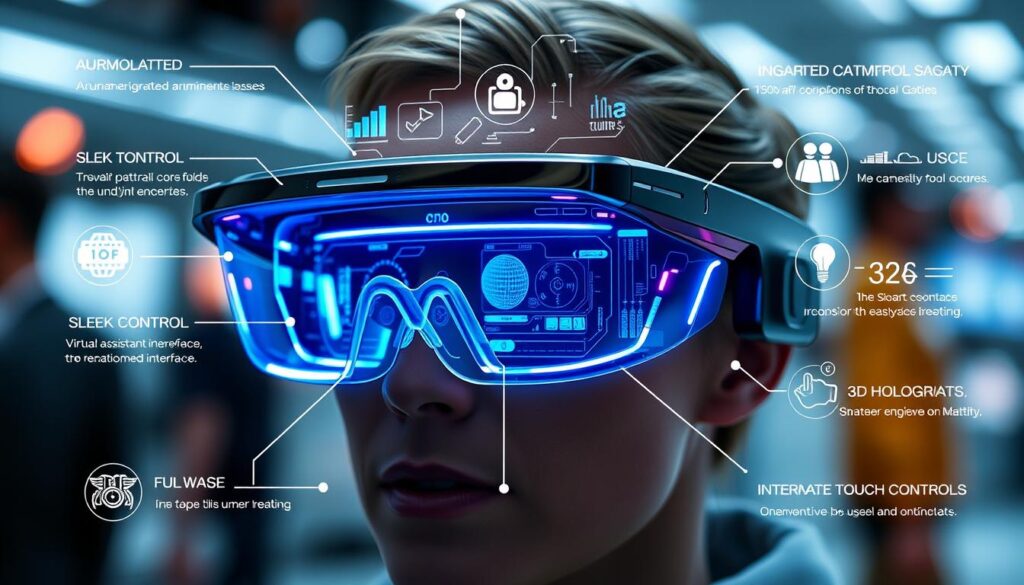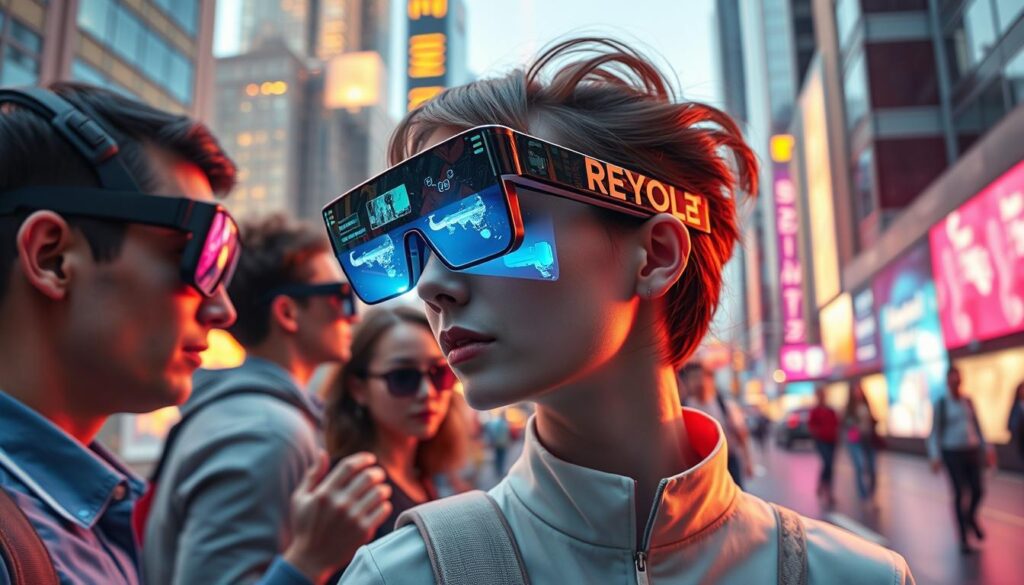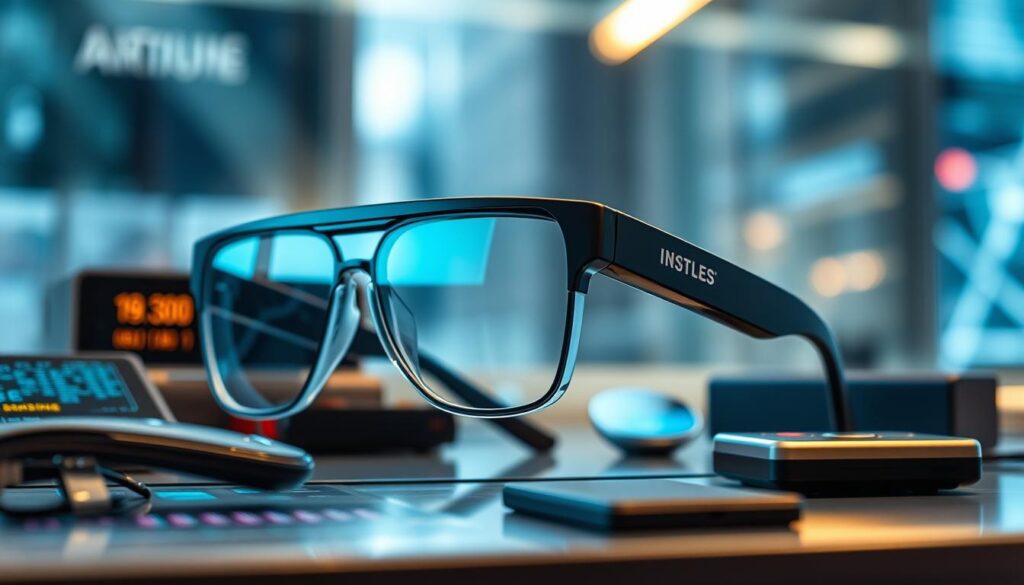Exploring smart glasses, I see a wide range of wearable tech. From simple Bluetooth glasses to advanced VR/AR/MR headsets, the market is growing fast.
Smart glasses come in at least 6 different tech levels. They promise to change how we use information, making our lives better with augmented reality. This is why more people want them.
Smart glasses have cameras and microphones for hands-free use. This makes them different from regular Bluetooth devices. As they become more popular, it’s important to think about how they’ll change our daily lives.
Key Takeaways
- Smart glasses are getting more popular because they offer a seamless experience, like wearable tech.
- There are many types of smart glasses, from simple to advanced, showing growing interest in the market.
- With cameras and microphones, smart glasses offer hands-free use, using augmented reality to improve our lives.
- Smart glasses could change how we interact with information, affecting many areas like healthcare and education.
- It’s important to look at the good and bad of smart glasses as they evolve, considering their impact on our lives.
- The price of smart glasses, like the Ray-Ban Meta at $299, is a big factor in their adoption.
- The quality of photos and videos from smart glasses, like the Ray-Ban Meta, is good, showing their promise.
Smart Glasses: The Next Big Thing? Understanding the Basics
Exploring smart glasses, I see fast progress in this area. The Smart Glasses Definition now covers many devices. These range from simple Bluetooth glasses to advanced AR headsets.
Big names like Meta, Apple, and Vuzix lead the smart glasses market. They’re making smart glasses do more. Key techs include AR, VR, and AI.
For example, Meta’s Ray-Ban lets users capture photos and videos. Vuzix’s Z100 has a small screen for a HUD. Solos smart glasses are for athletes, showing speed, heart rate, and distance in real-time.
| Smart Glasses Model | Features |
|---|---|
| Meta Ray-Ban | Take photos, videos, and livestream |
| Vuzix Z100 | Heads-up display (HUD) |
| Solos | Real-time metrics for athletes |
In conclusion, smart glasses are changing fast. New tech and ideas keep coming. It’s thrilling to see how they’ll change our future and daily lives.
Design and Build Quality Analysis
Manufacturers are now making Smart Glasses Design sleek and premium. They aim to make devices that look good and feel comfortable. The build quality is key, as it impacts durability and performance. High-quality Materials ensure smart glasses can handle daily wear.
Some smart glasses, like the XREAL Air, are lightweight and have high-resolution displays. They are perfect for long use. Their Build Quality is top-notch, with a strong build that can handle rough use. Their Smart Glasses Design is sleek and modern, appealing to many users.
The Materials in smart glasses matter a lot. They affect the device’s weight, durability, and performance. For instance, lithium-ion batteries with a thin design reduce weight and boost battery life. The image shows the sleek design of smart glasses, thanks to quality materials and focus on build quality.
In summary, the Design and Build Quality of smart glasses are vital. By focusing on sleek, premium devices with quality materials, manufacturers can create durable and comfortable smart glasses.
Core Features and Functionality Deep Dive
Exploring smart glasses, I’m amazed by their features and functions. They bring new ways to interact with information. Key Smart Glasses Features include a seamless and immersive experience.
The Display Technology in smart glasses is vital. It has improved, making displays high-resolution and visual experiences unmatched. The Audio Capabilities have also grown, allowing for clear sound and hands-free talks.

- Advanced Display Technology for an immersive visual experience
- Enhanced Audio Capabilities for crystal-clear sound
- Seamless connectivity options for effortless communication
In summary, smart glasses offer impressive features and functions. They provide a unique and engaging experience. With ongoing improvements in Display Technology and Audio Capabilities, they’re set to change how we interact with information and each other.
Real-World Performance Testing
When I explore Smart Glasses Performance in real life, I look at the Real-World Visualisation market. It has many uses. The User Experience is key, and I check how well they work in daily tasks like walking and cycling.
Testing smart glasses shows their power to help people with vision or hearing issues. For example, the Ray-Ban Meta smart glasses got new updates fast. They now have basic voice assistants from Meta AI. This tech could change how we use media, like ChatGPT has in different fields.
Some important features of smart glasses are:
- Heads-up display (HUD) that shows real-time data
- Turn-by-turn navigation system
- Display metrics like speed, time, distance, calories burned, and heart rate
- Voice commands and touch gestures for hands-free control

The Smart Glasses Performance also depends on their design and quality. The Solos Smart Glasses are light and aerodynamic. They’re made for serious athletes who want to improve their performance. This tech aims to revolutionize smart eyewear, giving fitness fans quick access to key performance data.
User Experience and Comfort Assessment
When we talk about Smart Glasses User Experience, we must think about Comfort and how well they fit into our social lives. The design of smart glasses really matters. If they’re made to fit well and feel good, we enjoy wearing them more.
Learning to use smart glasses is a big part of the experience. An easy-to-use interface makes a big difference. Also, how others see us wearing them is important. It affects how we feel about using them in public.
- Adjustable frames for improved Comfort
- Intuitive interface for ease of use
- Stylish designs to enhance Social Acceptance
By focusing on these aspects, makers can create smart glasses that are easy to use and fun to wear. This can help more people want to use them, making them more accepted in society.
| Feature | Impact on User Experience |
|---|---|
| Comfort | Enhances daily wear comfort |
| Intuitive Interface | Reduces learning curve and improves ease of use |
| Social Acceptance | Influences public perception and interaction with smart glasses |
Price-to-Value Analysis
When looking at the Smart Glasses Price, it’s key to check the Value Analysis. This means looking at the features, how well they work, and their cost. A comparison with competitors can show the top choices in the market.
The Ray-Ban Meta Smart Glasses cost $299.99 and have a 12MP camera and open-ear speakers. The Xreal One AR Glasses are $499 and offer a 130-inch virtual display.
The price of Smart Glasses changes a lot based on the brand, what it can do, and who it’s for. For example, the Solos AirGo Vision Smart Glasses are $299 and use GPT-4 for translations and info. On the other hand, the Viture Pro XR Glasses are $499 and are great for gaming and spatial computing.
The market has both affordable and high-end smart glasses. Knowing how you’ll use them affects their value. With the global smart glasses market growing fast, it’s important to do a detailed Value Analysis before buying.
In the end, the Smart Glasses Price is just part of the value. By looking at features, performance, and price, and comparing competitors, you can choose wisely and get the best deal.
Conclusion: Are Smart Glasses Ready for Prime Time?
Our deep dive into smart glasses shows they’re making progress, but not quite ready for everyone yet. They’ve improved a lot, with better displays, sound, and battery life. Yet, they struggle with being accepted socially, fitting into work, and being affordable for most people.
The future for smart glasses looks bright, with big names like Meta and Apple diving into augmented reality (AR). As AR grows, we’ll see more ways to easily get information without using our hands. Fields like logistics, healthcare, and construction will likely see big benefits from smart glasses, making work easier and more efficient.
We think smart glasses are worth looking into, mainly for businesses where they can save a lot of money. But for regular folks, the high cost and limited features might hold them back. As tech gets better and people become more open to new ideas, smart glasses could soon be a must-have in our daily lives.



